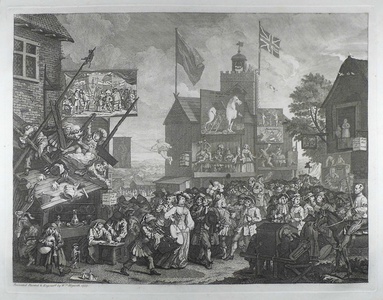| Method | Copper engraving and etching |
| Artist | William Hogarth |
| Published | Invented Painted & Engrav'd by Wm. Hogarth 1733. [J & J Boydell c.1795] |
| Dimensions | Image 342 x 454 mm, Plate 364 mm, Sheet 434 x 588 mm |
| Notes |
A very lively and complex engraving of Southwark Fair, which was held around Borough High St each year in September, until its abolition in 1762 by the Court of Common Council. The fair gathered a reputation for all manner of violence and vice, and these various circumstances of criminality and tumult are depicted expertly by Hogarth in this scene. In the heaving square between near St George's Church are numerous amusements, theatrical booths, and street performances. Banners slung from the surrounding buildings advertise such diverse theatrical performances as the Drury Lane 'Stage Mutiny,' the 'Seige of Troy,' 'Punches Opera,' the Fall of Man from Eden, and even a Royal Waxworks of the Court of France. To the left, a performance of the 'Fall of Bajazet' experiences an appropriately ironic fall of its own, as the stage collapses onto a booth selling ceramics. Between two of the buildings, a tightrope walker hangs suspended from a line, while a rope-flyer dives from the church tower in the distance. The crowd at centre is a motley collection of caricatures. A dwarf playing bagpipes stands alongside a trained dog, walking on its back legs and dressed in the habit of a gentleman. A black trumpeter and a drummer-girl lead a band through the crowd, while one of their number, in Roman dress, is accosted by the bailiffs. To the right, a wastrel chats up two country girls, one of whom closely resembles Moll from Hogarth's celebrated 'Harlot's Progress.' In the extreme right, the broadsword fighter James Figg sits atop his blind horse, brandishing his weapon, while two figures sit observing a peepshow in a small hutch. Hogarth's advertisements for the Southwark Fair suggest that it was originally intended as a coda for his 'Rake's Progress,' though owing to delays in finishing the series, the Southwark Fair was actually published before the Rake. William Hogarth (1697 - 1764) was born in London, the son of an unsuccessful schoolmaster and writer from Westmoreland. After apprenticeship to a goldsmith, he began to produce his own engraved designs in about 1710. He later took up oil painting, starting with small portrait groups called conversation pieces. He went on to create a series of paintings satirising contemporary customs, but based on earlier Italian prints, of which the first was The Harlot's Progress (1731), and perhaps the most famous The Rake's Progress. His engravings were so plagiarised that he lobbied for the Copyright Act of 1735, commonly referred to as 'Hogarth's Act,' as a protection for writers and artists. During the 1730s Hogarth also developed into an original painter of life-sized portraits, and created the first of several history paintings in the grand manner. Paulson 131 i/i, BM Satires 1960 Condition: Excellent impression with full margins. Light foxing and manuscript number to margin, not affecting image or plate. |
| Framing | unmounted |
| Price | £700.00 |
| Stock ID | 38032 |

